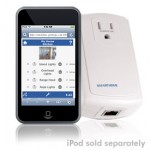Putting the “smart” in SmartLinc
My previous post talked about my latest hobby, Insteon-based home automation. My first purchase in this regard was a set of light switches that I wired into our home, as well as a controller called “SmartLinc” that facilitates control over my setup. Basically it is a small box that plugs into the wall and also plugs into your home internet router. It runs a small web server that you can then access to see which lights are on in your house, which plugs are turned on, and so on.
 The problem is, this SmartLinc isn’t very smart. It’s very attractive for new users such as myself because it has a picture of an iPhone on the kit and a built-in preconfigured web server. As many users soon find out, it’s only use is for turning things on and off via a timer or manually by a web browser. More advanced functionality such as making use of “trigger” events (whereby a motion sensor sees movement, or a door sensor activates), advanced dynamic schedules, and so on require a different type of device.
The problem is, this SmartLinc isn’t very smart. It’s very attractive for new users such as myself because it has a picture of an iPhone on the kit and a built-in preconfigured web server. As many users soon find out, it’s only use is for turning things on and off via a timer or manually by a web browser. More advanced functionality such as making use of “trigger” events (whereby a motion sensor sees movement, or a door sensor activates), advanced dynamic schedules, and so on require a different type of device.
These other, more capable, devices come in two categories. One type is an all-in-one solution, like the ISY which acts as a controller and as a bridge between the controller and the powerline for communications. The main benefit of these is that they are self-contained. Easy to install, easy to replace, and reasonably easy to configure through a web browser.
The other type is simply the communications bridge between a computer that you supply, and the modules you have installed. This is often referred to as a powerline modem (PLM). The biggest benefit of this arrangement is that now you can choose the software you want to run to control your house. If there’s something you don’t like, you can change the software package you use or write some scripts yourself. The disadvantage of course is that you have to have a computer in your house that is always connected to the internet and is always turned on.
What’s my point? Well, I have reason to believe that the SmartLinc is smarter than the manufacturers have let on. I would wager that the device can also double as a PLM. This means it may be the perfect device for hobbyists, since it would allow standalone access to simple functions, as well as (simultaneously) allowing a computer to send commands to it to talk to the powerline. Unfortunately, no software package out there really supports this functionality yet.
Accessing the SmartLinc is normally done through a web browser, which accesses port 80 on the device. Observant individuals (1, 2) have noted that another port is “open” and accepts connections, namely port 9761. Cursory investigations seem to suggest that this port can be used to send and receive the same serial code used on PLMs sold specifically for that purpose. I know of only one software program that is actively investigating supporting the SmartLinc for use as a PLM via this method, meaning that you might be able to use a SmartLinc in a truly smart way — as a quick standalone interface to controlling switches, and as part of a larger system with advanced schedules and triggers.
The only semi-official word I’ve seen on the purpose of the port being open is from a post made on this forum
It is our (SmartHome’s) goal to provide a pass-through mode for the SmartLinc Controller so that if Ethernet data is sent to Port x-x-x-x of the SmartLinc, those signals would just be passed through the SmartLinc Ethernet daughter board to the PowerLinc Modem main board. This ability and Matt’s support to have Indigo speak “PLM” is about a year away. When this happens, I expect Matt and his software to be the first to support it…
That post was written in 2009, and I’m guessing they’re talking about port 9761. No one (yet) supports it apart from a few programs. MiCasa for iPhone is one, but there are others on the way 😉
UPDATE (Feb 2, 2011): A program called Shion now supports communication with the SmartLinc via this undocumented protocol. Not only that, but the author Chris Karr, has made his code available to all developers. His words, “it may now be one of my favorite [insteon] controllers”.
UPDATE #2 (Apr 9, 2011): This forum thread is tracking some interested developments by the Insteon community! Now let’s see a few companies start to adopt this too! Hey, it’d open up a whole market of SmartLinc users for their product, so why not? 😉
Explore posts in the same categories: My life, Technology